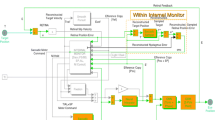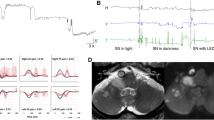Abstract
A woman, age 44, with a positive anti-YO paraneoplastic cerebellar syndrome and normal imaging developed an ocular motor disorder including periodic alternating nystagmus (PAN), gaze-evoked nystagmus (GEN) and rebound nystagmus (RN). During fixation there was typical PAN but changes in gaze position evoked complex, time-varying oscillations of GEN and RN. To unravel the pathophysiology of this unusual pattern of nystagmus, we developed a mathematical model of normal function of the circuits mediating the vestibular-ocular reflex and gaze-holding including their adaptive mechanisms. Simulations showed that all the findings of our patient could be explained by two, small, isolated changes in cerebellar circuits: reducing the time constant of the gaze-holding integrator, producing GEN and RN, and increasing the gain of the vestibular velocity-storage positive feedback loop, producing PAN. We conclude that the gaze- and time-varying pattern of nystagmus in our patient can be accounted for by superposition of one model that produces typical PAN and another model that produces typical GEN and RN, without requiring a new oscillator in the gaze-holding system or a more complex, nonlinear interaction between the two models. This analysis suggest a strategy for uncovering gaze-evoked and rebound nystagmus in the setting of a time-varying nystagmus such as PAN. Our results are also consistent with current ideas of compartmentalization of cerebellar functions for the control of the vestibular velocity-storage mechanism (nodulus and ventral uvula) and for holding horizontal gaze steady (the flocculus and tonsil).






Similar content being viewed by others
Code availability
Program code and model parameter data sets will be made freely available for academic use upon request.
References
Baloh, R. W., Honrubia, V., & Konrad, H. R. (1976). Periodic alternating nystagmus. Brain. Journal of Neurology, 99, 11–26. https://doi.org/10.1093/brain/99.1.11
Bögli, S. Y., Straumann, D., Schuknecht, B., et al. (2020). Cerebellar rebound nystagmus explained as gaze-evoked nystagmus relative to an eccentric set point: implications for the clinical examination. Cerebellum Lond Engl. https://doi.org/10.1007/s12311-020-01118-6
Cannon, S. C., & Robinson, D. A. (1987). Loss of the neural integrator of the oculomotor system from brain stem lesions in monkey. Journal of Neurophysiology, 57, 1383–1409.
Cohen, B., Helwig, D., & Raphan, T. (1987). Baclofen and velocity storage: a model of the effects of the drug on the vestibulo-ocular reflex in the rhesus monkey. Journal of Physiology, 393, 703–725.
Furman, J. M., Wall, C., & Pang, D. L. (1990). Vestibular function in periodic alternating nystagmus. Brain: A Journal of Neurology, 113(Pt 5), 1425–1439. https://doi.org/10.1093/brain/113.5.1425
Furman, J. M. R., Hain, T. C., & Paige, G. D. (1989). Central adaptation models of the vestibulo-ocular and optokinetic systems. Biological Cybernetics, 61, 255–264.
Halmagyi, G. M., Rudge, P., Gresty, M. A., et al. (1980). Treatment of periodic alternating nystagmus. Annals of Neurology, 8, 609–611. https://doi.org/10.1002/ana.410080611
Hess, K. (1982). Do peripheral-vestibular lesions in man affect the position integrator of the eyes? Neuroscience Letters Supplement, 10, 242–243.
Hood, J. D. (1981). Further observations on the phenomenon of rebound nystagmus. Annals of the New York Academy of Sciences, 374, 532–539. https://doi.org/10.1111/j.1749-6632.1981.tb30898.x
Hood, J. D., Kayan, A., Leech, J., et al. (1973). Rebound nystagmus. Brain, 96, 507–526.
Jeong, H. S., Oh, J. Y., Kim, J. S., et al. (2007). Periodic alternating nystagmus in isolated nodular infarction. Neurology, 68, 956–957. https://doi.org/10.1212/01.wnl.0000257111.24769.d2
Leigh, R. J., Robinson, D. A., & Zee, D. S. (1981). A hypothetical explanation for periodic alternating nystagmus: instability in the optokinetic-vestibular system. Annals of the New York Academy of Sciences, 374, 619–635. https://doi.org/10.1111/j.1749-6632.1981.tb30906.x
Leigh, R. J., & Zee, D. S. (2015). The Neurology of Eye Movements. Oxford University Press.
Oh, Y. M., Choi, K. D., Oh, S. Y., & Kim, J. S. (2006). Periodic alternating nystagmus with circumscribed nodular lesion. Neurology, 67, 399. https://doi.org/10.1212/01.wnl.0000219818.35451.10
Optican, L. M., & Zee, D. S. (1984). A hypothetical explanation of congenital nystagmus. Biological Cybernetics, 50, 119–134. https://doi.org/10.1007/BF00337159
Otero-Millan, J., Colpak, A. I., Kheradmand, A., & Zee, D. S. (2019). Rebound nystagmus, a window into the oculomotor integrator. Progress in Brain Research. https://doi.org/10.1016/bs.pbr.2019.04.040
Raphan, D. T., Matsuo, V., & Cohen, B. (1979). Velocity storage in the vestibulo-ocular reflex arc (VOR). Experimental Brain Research, 35, 229–248. https://doi.org/10.1007/BF00236613
Ritter, M. S., Bertolini, G., Straumann, D., & Bögli, S. Y. (2020). Prevalence and characteristics of physiological gaze-evoked and rebound nystagmus: implications for testing their pathological counterparts. Frontiers in Neurology, 11, 547015. https://doi.org/10.3389/fneur.2020.547015
Robinson, D. A. (1973). Oculomotor control system. Investigative Ophthalmology, 12, 164–166.
Robinson, D. A. (1974). The effect of cerebellectomy on the cat’s vestibulo-ocular integrator. Brain Research, 71, 195–207. https://doi.org/10.1016/0006-8993(74)90961-5
Robinson, D. A., Zee, D. S., Hain, T. C., et al. (1984). Alexander’s law: Its behavior and origin in the human vestibulo-ocular reflex. Annals of Neurology, 16, 714–722. https://doi.org/10.1002/ana.410160614
Shemesh, A. A., & Zee, D. S. (2019). Eye movement disorders and the cerebellum. Journal of Clinical Neurophysiology, 36, 405–414. https://doi.org/10.1097/WNP.0000000000000579
Waespe, W., Cohen, B., & Raphan, T. (1985). Dynamic modification of the vestibulo-ocular reflex by the nodulus and uvula. Science, 228, 199–202.
Zee, D. S., Jareonsettasin, P., & Leigh, R. J. (2017). Ocular stability and set-point adaptation. Philosophical Transactions of the Royal Society B: Biological Sciences, 372, 20160199. https://doi.org/10.1098/rstb.2016.0199
Zee, D. S., Leigh, R. J., & Mathieu-Millaire, F. (1980). Cerebellar control of ocular gaze stability. Annals of Neurology, 7, 37–40. https://doi.org/10.1002/ana.410070108
Zee, D. S., Optican, L. M., Cook, J. D., et al. (1976). Slow saccades in spinocerebellar degeneration. Archives of Neurology, 33, 243–251.
Zee, D. S., Yamazaki, A., Butler, P. H., & Gücer, G. (1981). Effects of ablation of flocculus and paraflocculus of eye movements in primate. Journal of Neurophysiology, 46, 878–899.
Acknowledgements
This study was supported by the David Robinson scholarship fund (Ari A Shemesh), the Betty and Paul Cinquegrana endowment (Ari A Shemesh, Jorge Otero-Millan and David S Zee), Leon Levy foundation (Jorge Otero-Millan) and NEI K99EY027846 and R00EY027846 (Jorge-Otero-Millan).
Author information
Authors and Affiliations
Corresponding author
Ethics declarations
Ethics approval
The Dokuz Eylül University Review Board approved the experimental protocol. Written informed consent to publish obtained from the patient.
Conflicts of interest
The authors declare that they have no conflict of interest.
Additional information
Communicated by Action Editor: Philippe Lefevre.
Publisher's Note
Springer Nature remains neutral with regard to jurisdictional claims in published maps and institutional affiliations.
This article belongs to the Topical Collection: Vision and Action Guest Editors: Aasef Shaikh and Jeffrey Shall
Supplementary Information
Below is the link to the electronic supplementary material.
Supplementary file1 (MP4 91300 KB)
Rights and permissions
About this article
Cite this article
Shemesh, A.A., Kocoglu, K., Akdal, G. et al. Modeling the interaction among three cerebellar disorders of eye movements: periodic alternating, gaze-evoked and rebound nystagmus. J Comput Neurosci 49, 295–307 (2021). https://doi.org/10.1007/s10827-021-00790-9
Received:
Revised:
Accepted:
Published:
Issue Date:
DOI: https://doi.org/10.1007/s10827-021-00790-9




